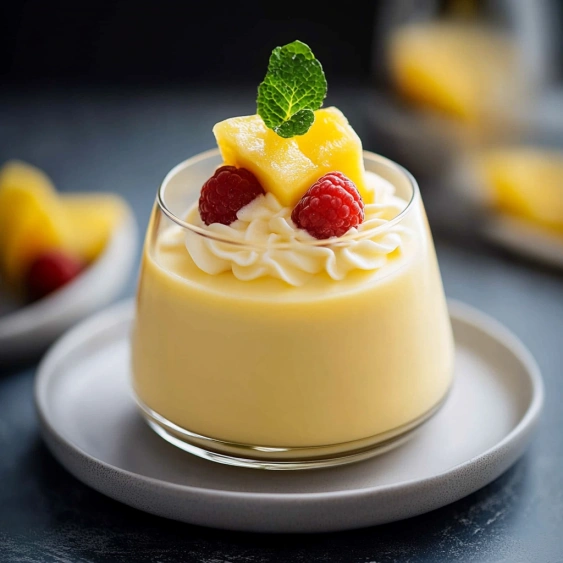 Pin it
Pin it
This silky smooth mango mousse brings the taste of tropical paradise to your dessert table without complicated techniques. The bright, sunny flavor is enhanced with just the right touch of sweetness and a hint of lemon that makes the mango shine.
I created this recipe during a particularly hot summer when I was craving something cool and refreshing but didn't want to turn on the oven. Now it's become my signature dessert whenever mangos are in season.
Ingredients
- Fresh mangos: Provide the vibrant flavor foundation; choose ripe fruits that yield slightly to pressure and have a sweet fragrance
- Powdered sugar: Blends seamlessly into the mixture without any grittiness; adjust quantity based on your mangos' natural sweetness
- Lemon juice: Brightens and enhances the mango flavor; this is a crucial ingredient that balances sweetness
- Gelatin powder: Creates the perfect set texture without making the mousse rubbery
- Heavy cream: With at least 36% fat content ensures proper whipping and structure; use it directly from the refrigerator
- Fresh herbs: Like mint add a beautiful color contrast and aromatic note to the finished dessert
Step-by-Step Instructions
- Prepare the mango puree:
- Clean and cut mangos, then blend until completely smooth. If using frozen mangos, allow them to reach room temperature before pureeing, then cook the puree over medium heat for about 10 minutes to reduce excess moisture. Measure after this process to ensure you have exactly 2 cups.
- Sweeten and flavor the puree:
- Mix sifted powdered sugar and freshly squeezed lemon juice into the mango puree. Take time to taste and adjust sweetness as needed, remembering that the cream will dilute the flavor slightly.
- Prepare the gelatin:
- Sprinkle gelatin powder over 2 tablespoons of cold water in a small bowl. Allow it to sit undisturbed for exactly 3 minutes until it becomes thick and jiggly. This blooming process ensures proper dissolution. Gently heat in the microwave just until liquid but not hot. The temperature balance is crucial here.
- Combine gelatin and fruit puree:
- Add the dissolved gelatin to your fruit mixture, ensuring the puree is at room temperature. If the puree is too cold, the gelatin might set prematurely, creating lumps. If too hot, it could destroy the gelatin's setting properties.
- Whip the cream:
- Using an electric mixer, whip the very cold heavy cream until it reaches early stiff peaks. Watch carefully as the texture changes. The perfect consistency should hold its shape while still being smooth and glossy. You should see peaks that slightly bend at the tips.
- Fold components together:
- Using a rubber spatula, gently fold the whipped cream into the mango mixture with a down-across-up-over motion. Work methodically but quickly to maintain as much air as possible while ensuring no streaks remain.
- Portion and refrigerate:
- Transfer the finished mousse to serving cups using either a spoon or piping bag for a more refined presentation. Refrigerate for a minimum of 6 hours to allow the gelatin to fully set.
 Pin it
Pin it
The mangos are truly the star of this recipe. I remember making this mousse for my mother's birthday one year, and she was transported back to her childhood in the Philippines where she grew up with mango trees in her backyard. The pure, unadulterated mango flavor is what makes this dessert truly special.
Serving Suggestions
This mousse pairs beautifully with buttery shortbread cookies or thin wafers that provide textural contrast without competing with the delicate flavor. For a more substantial dessert, layer the mousse with cubes of pound cake in clear glasses to create an impressive trifle-like presentation. The dessert is elegant enough for special occasions but simple enough for an everyday treat.
Troubleshooting Tips
If your mousse isn't setting properly, the most common cause is underwhipped cream. The cream needs to reach early stiff peaks to provide structure. Another possibility is that the gelatin wasn't properly bloomed or was overheated, destroying its setting properties. Remember that patience is key when allowing the dessert to set—a full 6 hours minimum in the refrigerator is necessary.
Seasonal Variations
While mangos create a tropical delight, this mousse template works beautifully with seasonal fruits. Try strawberries in spring, peaches in summer, or even pumpkin puree in fall (which would require additional spices like cinnamon and nutmeg). Just remember that watery fruits may need cooking down to concentrate their flavor and reduce moisture, while naturally sweet fruits might need less added sugar.
 Pin it
Pin it
Frequently Asked Questions
- → Can I use frozen mangoes instead of fresh?
Yes, you can use frozen mangoes. However, you'll need to let them come to room temperature first, puree them, and then reduce the puree by cooking over medium heat for about 10 minutes until it thickens slightly and some water evaporates. This helps concentrate the flavor and reduce excess moisture that could prevent proper setting.
- → Why is lemon juice necessary in this mousse?
Don't skip the lemon juice as it enhances and brightens the mango flavor. The acidity in lemon juice balances the sweetness of the mangoes and adds complexity to the overall taste profile of the dessert.
- → How do I know when my cream is whipped to the right consistency?
Whip the cream just until early stiff peaks form - when you lift the beater, the peaks should hold their shape but have a slight bend at the tip. Don't overwhip as the cream can become too hard to fold into the fruit puree, or worse, it might break and start turning into butter.
- → Why didn't my mousse set properly?
Several factors could prevent proper setting: 1) The gelatin wasn't properly bloomed or was overheated, 2) The cream wasn't cold enough or was under-whipped, 3) If using frozen mangoes, the puree wasn't reduced enough to remove excess water, or 4) The setting time was insufficient - the mousse needs a full 6 hours to properly set.
- → Can I make this mousse ahead of time?
Yes! This mousse can be prepared up to 2 days in advance and stored refrigerated. This makes it perfect for entertaining. However, it's best to add the fresh fruit and herb garnishes just before serving for the freshest presentation. Do not freeze the mousse as it will damage the texture.
- → How can I adjust the sweetness of the mousse?
The sweetness can be easily customized based on your preference and the natural sweetness of your mangoes. After mixing the powdered sugar into the mango puree, taste it and add more sugar if needed. Very ripe mangoes will naturally be sweeter and may require less added sugar.
